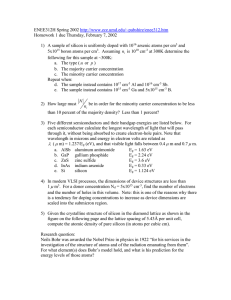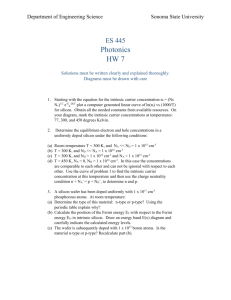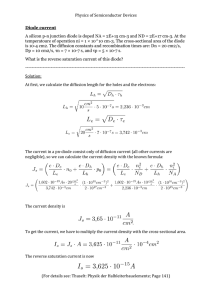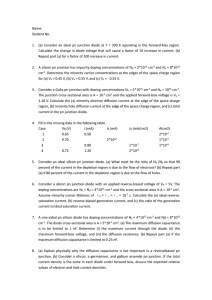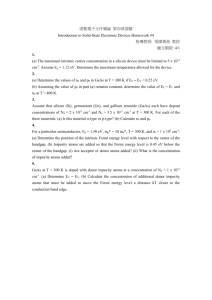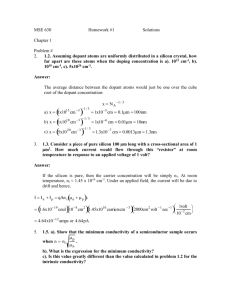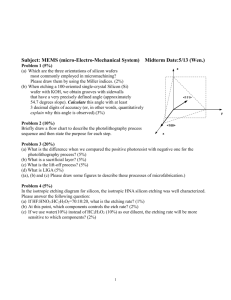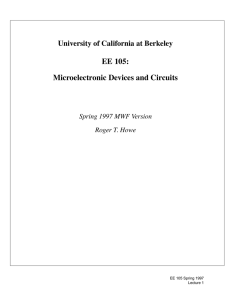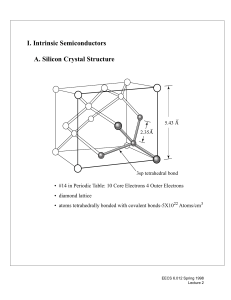Sample Midterm 1
advertisement
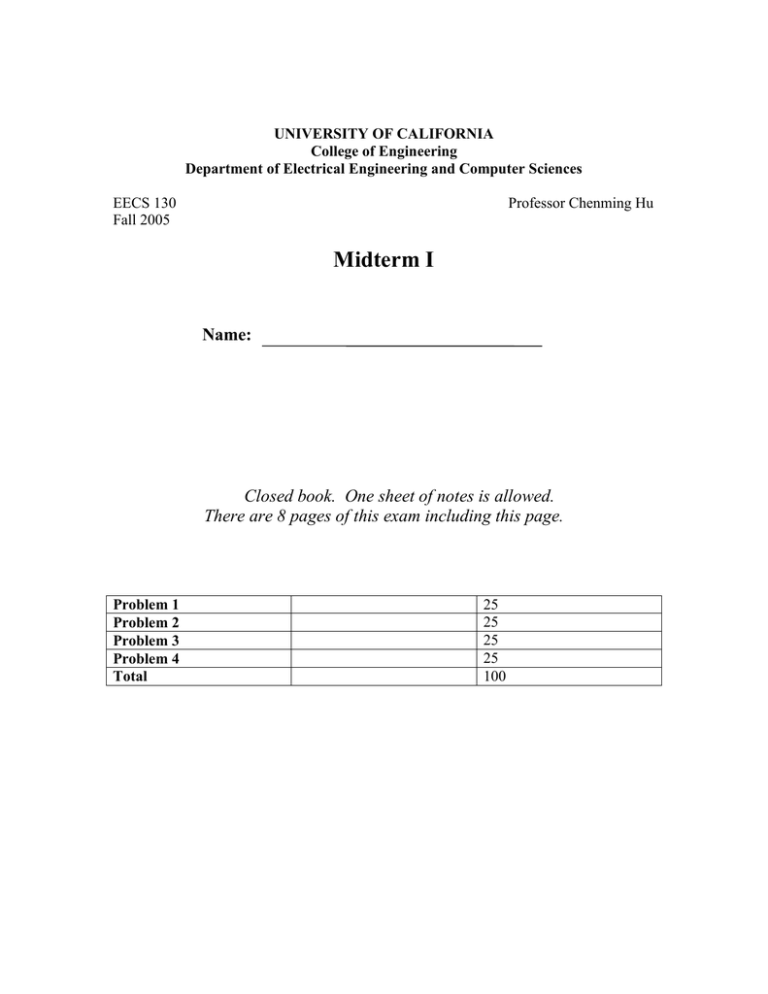
UNIVERSITY OF CALIFORNIA College of Engineering Department of Electrical Engineering and Computer Sciences EECS 130 Fall 2005 Professor Chenming Hu Midterm I Name: Closed book. One sheet of notes is allowed. There are 8 pages of this exam including this page. Problem 1 Problem 2 Problem 3 Problem 4 Total 25 25 25 25 100 Physical Constants Electronic charge q 1.60210-19 C Permittivity of vacuum 0 8.84510-14 F cm-1 Relative permittivity of silicon Si/0 11.8 Boltzmann’s constant k 8.617 x 10-5 eV/ K or 1.3810-23 J K-1 Thermal voltage at T = 300K kT/q 0.026 V Effective density of states Nc 2.8 x 1019 cm-3 Effective density of states Nv 1.04 x 1019 cm-3 1 01 6 Problem 1 Parts a, b, c and d are independent of each other. Assume Nc and Nv are independent of temperature. a) What fraction of donors is not ionized at room temperature if Ed is 50 meV above Ef. b) (i) Find the diffusion constant Dn of N-type silicon doped with Nd = 1016 cm-3 at T = 500K. (ii) Find the resistivity of silicon with Nd = 1016 cm-3 at T = 500K c) The equilibrium hole concentration is 1014 cm-3. (i) What is the electron concentration at T = 300K? (ii) What is the electron concentration, if 106 cm-3 of excess electrons are introduced? (iii) Given the recombination lifetime of electrons is 1μs. How many electrons are consumed by recombination per cm3 per s? (iv) How many holes are consumed by recombination per cm3 per s in the situation stated in part (iii)? Problem 2 Consider a bar of silicon with doping concentration Nd(x) = 1017e-bx, where b > 0. Assume full ionization, T = 300K and that Nc and Nv are independent of x. Assume that the electron and hole diffusion constants Dn and Dp are independent of x. You may leave final expressions in terms of Nc, Nv, b, Dp and Dn as required. Assume ni = 1010 cm-3. (a) Find hole concentration p(x). (b) Qualitatively sketch the energy band diagram. (label Ec, Ev and Ef and indicate clearly which of Ec, Ev or Ef, if any, are constants or independent of x) (c) Do the holes diffuse to the left or right? Find the hole diffusion current. (d) Do the holes drift to the left or the right? Find the hole drift current. (e) Compare the magnitudes of the hole diffusion and drift currents. (f) Now consider that the band gap, Eg varies as a function of x. Eg(x) = (1.1 – ax) eV, where a > 0. The doping concentration Nd(x) is still 1017e-bx, where b > 0 and you may still assume complete ionization. You may leave the final expression in terms of Nc, Nv, b, a, Dp and Dn as required. Find p(x). Problem 3 N+ P P+ L = 0.1μm Consider the above silicon diode. Assume that N+ and P+ regions are so heavily doped that Ec = Ef in the N+ region and EF = EV in the P+ region. The doping in the P-type region is 1017 cm-3. Assume that the P layer is thin enough that it is completely depleted. All calculations are done at T = 300K. (a) Sketch the energy band diagram for this diode. Do not be concerned with the exact shape of Ec(x) in the depletion region. (b) Find the built in potential (φbi) of the given diode in Volts. (c) Qualitatively draw the electric field in the semiconductor as a function of x. Hint use dε/dx = qN/ε. (d) Find the peak electric field in part (c). You may assume that the depletion region is entirely contained in the p region only. Problem 4 (a) Given below is a menu consisting of various fabrication processes you are familiar with. Using only these given processes, fill in and complete the given sequence of steps to fabricate the structure given on the following page, starting from a p-type silicon wafer. Hint: All given processes may or may not be required, and the same process maybe used multiple times. Processes Available: Diffusion CVD ( Chemical Vapor Deposition) Thermal oxidation Dry Etching or Reactive Ion Etching Lithography Wet Etching Ion implantation Sputtering Final structure to be fabricated: SiO2 N+ N+ Silicon Steps used to fabricate the structure: 1. 2. 3. 4. 5. Ion implantation (b) Very briefly describe the difference between isotropic and anisotropic etching. (c) Name the two different types of thermal oxidation. (d) What are the two different kinds of photoresists available? (e) What are the two commonly used types of CVD processes?
